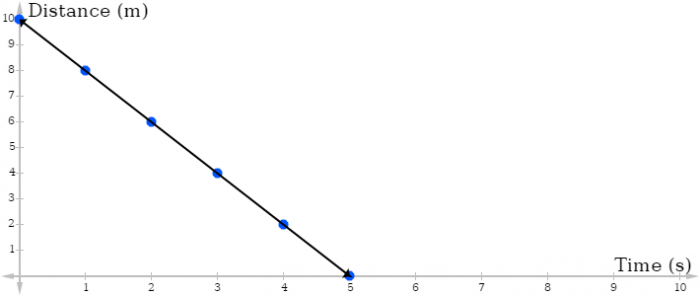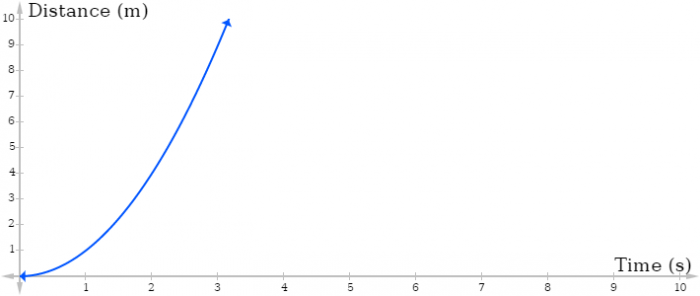How To Find Rate Of Change From A Graph

In mathematics, a rate of change is a mathematical expression that relates changes in ane quantity to changes in another quantity. Rates of modify are useful for describing how systems change over time and how a alter in i variable affects alter in another. Rates of change are useful is a number of fields where they are used to summarize a human relationship between ii variables.
A elementary case of a charge per unit of change is velocity. At its cadre, velocity is a charge per unit of change. Specifically, velocity describes a change in distance with respect to a alter in time. A velocity of 3 m/southward tells us that the deportation of an object is irresolute by 3 meters for every 1 2d. For every change in the independent variable (fourth dimension) the dependent variable (distance) changes by 3 meters.
Rates of modify are especially useful in algebra, calculus, and physics every bit those fields routinely deal with circuitous systems where continuous changes in one variable correlate with changes in another. Rates of modify allow us to draw and predict how ii quantities change with respect to each other.
Rate Of Change Formula
At its simplest, the charge per unit of modify of a function over an interval is only the quotient of the change in the output of a part (y) over the difference in the input of the function (ten) (change in y/modify in x)
![]()
More specifically, for any function ƒ(x), the boilerplate rate of change of that function over the interval a ≤ ten ≤ b is just:
![]()
The rate of change over an interval is a measure of how much the output of a part changes per unit of input over that interval.
Let's return to the example of velocity to see exactly how you lot can calculate a rate of change. Here is a tabular array describing the distance a machine covers over some given time:
| Time (seconds) | Altitude Traveled (meters) |
| 0 | 0 |
| 1 | 2 |
| 2 | four |
| iii | 6 |
| iv | viii |
| 5 | 10 |
The tabular array tells u.s.a. that at t=ane, the auto has moved 2 meters, at t=2 the object has moved 4 meters, at t=3 6, at t=4 8, and at t=5 ten meters. We want to figure out the charge per unit of change of the machine'southward displacement over fourth dimension over the interval 0 to 5 seconds. The average rate of modify can exist found by dividing the change in distance past the change in fourth dimension:
rate of change = Δdistance/Δtime
rate of change = (10-0)/(5-0) = 20/5 = 2 yard/southward
The average velocity of the object is 2 yard/s, meaning that for every second of time that passes, the distance traveled by the car changes past 2 meters. This is why velocity is a rate of change: it tells us how ane variable (distance) changes with respect to change in another variable (time). We tin use this information to predict how far the car volition travel in the future. Assuming the rate of change (velocity) remains constant, after 6 seconds the car will have traveled 12 meters, after seven seconds 14 meters, and so on.
Graphs And Rates Of Change
Graphing information points can exist helpful for visualizing rates of changes. Taking our time-altitude data points from the terminal section and placing it on an 10-y coordinate axis with time on the x-centrality and distance on the y-axis gives us:
Plotting our data points creates a nice line. Looking at the shape of the graph highlights an of import principle. The gradient of a item graph gives us of import information about the rate of modify of a function.
Recall that the slope of a graph between two points is equal to the change in the y-variable divided by the alter in the ten-variable. The slope of a graph tells united states of america the charge per unit of change of the output (y) of the graph with respect to changes in the input (x). For example, the slope of the graph between (ane, 2) and (ii, 4) can be discovered by the same formula:
slope = Δy/Δx ("rise"/"run")
slope = (4−two)/(ii−i) =2
The gradient of the graph is two meaning the charge per unit of change between the two points (ane, 2) and (2, iv) is two. The slope of the office corresponds to how "steep" the line on the graph is. The larger the slope, the steeper the line betwixt the 2 points, the smaller the gradient the less steep. If the gradient is negative then the rate of alter is also negative. For instance, say our car starts 10 meters away, and starts moving towards you:
| Time | Distance |
| 0 | 10 |
| i | 8 |
| 2 | 6 |
| 3 | 4 |
| four | ii |
| 5 | 0 |
What is the rate of change of these information points? Using our formula, we can summate:
rate of change = Δy/Δx
rate of change = (0−10)/(5−0) = −two
In this case, the rate of change is −two. This means that the y-value (distance) is changing by −ii for every unit of time. Graphing these information points gives united states:

Since the charge per unit of change is negative, the graph slopes downwards to the correct. The general shape of a graph can tell you general information virtually the charge per unit of modify of the function. If it slopes upwards to the right, so the rate of change is positive. If it slopes downward to the right, and then the rate of change is negative. Whether the rate of change is positive or negative tells us whether the output increases or decreases with respect to changes in the input.
Non-Constant Charge per unit Of Change
And so far, the examples nosotros have looked at involve a constant rate of change; i.e. the change in the output of the office is constant over every interval. In our previous examples with velocity, the rate of alter between each indicate in fourth dimension is the aforementioned, two m/s. Every second the cars altitude changes by a constant amount.
What about cases where the rate of change between each signal of the role is non constant? Say the data points for our moving auto instead look like this:
| Time (s) | Distance (m) |
| 0 | 0 |
| 1 | i |
| 2 | iv |
| iii | 9 |
| 4 | 16 |
| 5 | 25 |
Notice that between each point in time, the rate of change is different. From t=0 to t=1 seconds, the rate of modify is (1−0)/(1−0) = i just from t=ane to t=2 the charge per unit of change is (4−one)/(two−one) = iii. From t=2 to t=three, the charge per unit of alter is (9−iv)/(3−2) = 5 and from t=3 to t=4, the charge per unit of change is(xvi−9)/(4−3) = 7. At each point in time, the charge per unit of change of the role is increasing, significant that over time the car is accelerating. Graphing these data points gives us this shape:

Considering the rate of change is non constant, the graph does not look similar a straight line but instead takes on a curved shape. The curve of the line tells not just that the rate of change is positive (it slopes up to the correct) but besides that the rate of modify is increasing over the interval. The steeper the line between 2 points of the graph, the greater the charge per unit of change between those ii points are. Find how equally fourth dimension goes on, the graph gets steeper and steeper. The increasing steepness of the graph corresponds to an increasing rate of modify. Consequently, if the graph began at the top and sloped downward, that would indicate that the rate of modify is increasing in the negative direction.
Rate Of Alter Exercise Problems
Q1.)The displacement of a car with respect to time is given by the following tabular array:
| Time (s) | Displacement (k) |
| 0 | 5 |
| ane | two |
| two | 10 |
| 3 | 15 |
| 4 | 12 |
(i) What is the average rate of change of the displacement from the interval t=0 to t=four? (2) What is the average charge per unit of change between t=0 and t=one?
Respond:Using our rate of alter formula, we can figure out that the average rate of alter over the interval t=0 to t=iv is equal to:
rate of change = Δy/Δx
rate of change = (12−5)/(iv−0) = 7/iv.
(i) The average rate of alter of the car's deportation over time is 7/4
For (ii) we demand to figure out the rate of change between t=0 and t=1. These values are:
rate of change = (2−5)/(ane−0) = −3
The average charge per unit of change between t=0 and t=1 is −iii, meaning that deportation is decreasing between those 2 points in time.
Q.ii)The vertical tiptop of a projectile in freefall is given past the equation:d = ½gt two wherechiliad is the acceleration due to gravity (on World, g = −ix.8 k/stwo). If a missive is dropped off the leaning tower of Pisa, how far in meters will information technology fall in iii.4 seconds? What is the average velocity of the cannonball from t=1 to t=3?
We know that when t=0, the vertical height of the cannonballs is also 0 (because it has not been dropped yet). To find how much the deportation has changed in 3.4 seconds, we need to detect the vertical peak after three.four seconds accept passed. Using the freefall equation, we know that later iii.iv seconds, the cannonball volition have dropped:
d= ½(−9.viii)(3.iv)2
d = −56.4 meters. (the reply is negative considering the cannonball is moving down)
Later on three.4 seconds, the cannonball will take fallen 56.iv meters.
To find the average velocity of the cannonball from t=ane to t=3, we accept to find the deportation of the missive at each of those points. At t=one, the cannonball has fallen:
d = ½(−9.8)(1)ii
d =−4.9 meters.
Subsequently i second has passed, the cannonball has fallen iv.ix meters. At t=3:
d = ½(−ix.8)(three)two
d = −44.1 meters
After 3 seconds the missive will accept fallen 44.one meters. Thus the average velocity of the cannonball from t=ane to t=3 is:
rate of change = (−44.1−−4.9)/(3−1) = −19.six m/southward
Between the times t=1 and t=3, the cannonball has an average velocity of −xix.6 1000/due south.
Source: https://sciencetrends.com/rate-of-change-formula/
Posted by: romerobeatee.blogspot.com


0 Response to "How To Find Rate Of Change From A Graph"
Post a Comment